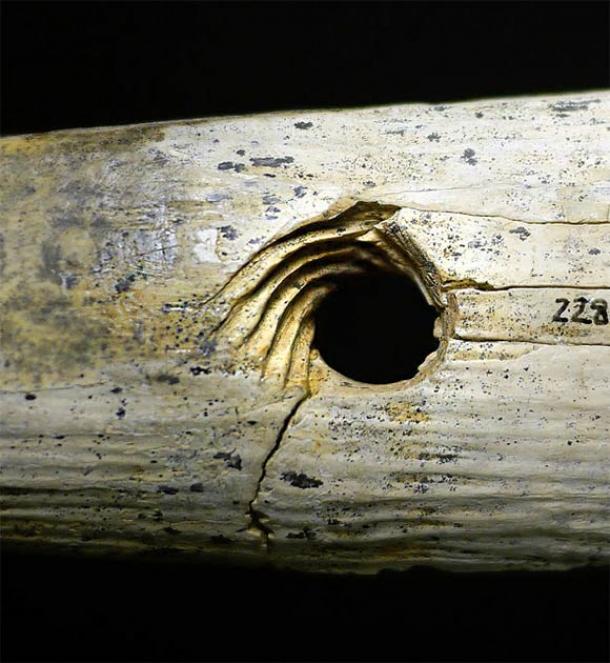A team of scientists have identified a Stone-Age cordage tool used to manufacture rope. And the use of this tool completely changed human life and productivity in prehistoric times. A series of slow advancements in cordage production technology allowed humans to progress from the primitive lashing and binding of tree vines and roots required to drag heavy dead animals back to campsites from hunting planes, to the manufacture of the immense steel cables used in modern industry. The newly discovered Stone-Age cordage tool, according to researchers, was a huge breakthrough in the rope making process.

Nicholas Conard at the University of Tübingen Museum was the first archaeologist to understand the mammoth bone Stone-Age cordage tool (Friedhelm Albrecht / CC BY-SA 2.0 )
Nicholas Conard, director of the Institute of Archaeological Sciences at the University of Tübingen University was the first archaeologist to explore the Hohle Fels cave in southwestern Germany. And during his investigations his team found a 40000-year-old, bar of mammoth bone, twenty centimeters (8 inches) in length, that had four holes drilled in it. Inspection of the artifact showed that each hole was lined with ‘precisely cut spiral incisions.’ Archaeologists have since determined that this unique tool was created by a Stone-Age cordage production specialist.

Close up of the mammoth bone rope making tool showing the precisely cut spiral incisions. ( University of Tübingen )
Replacing the God of The Gaps with Science
The term “god of the gaps” is popularly used by atheists to describe gods existing in any circumstance science cannot currently explain, but this term is also used in archaeology to refer to any artifact that cannot be immediately identified and is thus usually classified as “ritualistic” or “ceremonial.” The world’s museums are filled with survival tools that have been misinterpreted or which are not fully understood. And the original purpose of this strange mammoth bone tool was no different. According to a report in The Guardian the archaeologists first believed this artifact might have been part of a musical instrument, “or a religious object.”
However, when Dr. Veerle Rots of the University of Liege in Belgium, fed raw plant fibers through the holes of a bronze replica of the mammoth bone tool, he was able to create four separate twisted strands that could be combined to form rope, chords, twines and yarns. And as the earliest known tool for making rope, ‘its impact would have been revolutionary’ stated Rots, allowing for advancements in bow and arrow manufacture, fishing and hunting nets, snares and traps, and for making better clothing and containers for carrying food.
Ropes Bound the Stone Age Together
While the mammoth bone tool from Hohle Fels cave is impressive it is not the only one. According to Prof Chris Stringer of the Natural History Museum in London, a range of similar tools were also discovered in Gough’s cave in Cheddar Gorge, England, that demonstrate how rope was made in Britain at the end of the last ice age . Thought to be about 15,000 years old and constructed using reindeer antler devices, the Cheddar Gorge devices have the same holes with spiral incisions as the Hohle Fels cave mammoth bone tool.
But because the mammoth bone cordage tool was discovered in one of the most remote Stone-Age sites in Europe, dating from the early Stone Age, scientists say this “indicates rope-making had already become a vitally important human activity” much earlier than previously thought.
Untwisting the History of Cordage Production
When the 15,000-year-old cordage production tools were first discovered in Gough ’s cave in Cheddar Gorge they were incorrectly categorized as ritual “batons,” thought to have been carried by tribal chiefs as indicators of rank. But the spiral holes, through further research, were found to have a specific function. It is now clear that they must have been used to make or manipulate rope. Dr Rots stated that this mammoth-bone cordage tool ‘answers the question of how rope was made in the Paleolithic, which according to him “has puzzled scientists for decades.”
This single Stone-Age artifact is proving to be the key discovery that shows that cordage production had become widespread in the upper Paleolithic period . The team of researchers have now concluded that early rope manufacturing devices were created by some of the first Homo sapiens to reach Europe after they left Africa about 60,000 years ago.
Top image: Stone-Age mammoth bone cordage tool found at Hohle Fels cave in Germany that scientists now recognise as a rope-making tool from 40,000 years ago. Source: University of Tübingen
By Ashley Cowie
 RSS Feed
RSS Feed















 August 2nd, 2020
August 2nd, 2020  Awake Goy
Awake Goy  Posted in
Posted in  Tags:
Tags: 













